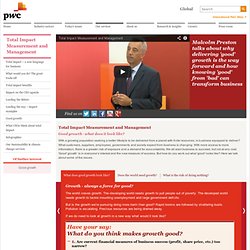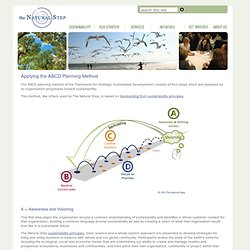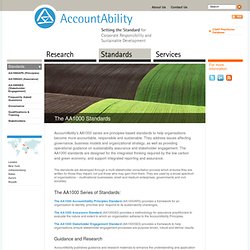

Systems thinking: a cautionary tale (cats in Borneo) Triple bottom line & sustainability: the science of good business. Steve Howard: Let's go all-in on selling sustainability. The Story of Change. The Latest Changes And Trends In Corporate Sustainability. Let’s close the loop. The KPMG Survey of Corporate Responsibility Reporting 2013. Sustainability definition: scientific & simple (Part 1)
The circular model - an overview. The linear ‘take, make, dispose’ model relies on large quantities of easily accessible resources and energy, and as such is increasingly unfit for the reality in which it operates.

Working towards efficiency—a reduction of resources and fossil energy consumed per unit of manufacturing output—will not alter the finite nature of their stocks but can only delay the inevitable. A change of the entire operating system seems necessary. The circular economy principle The circular economy refers to an industrial economy that is restorative by intention; aims to rely on renewable energy; minimises, tracks, and hopefully eliminates the use of toxic chemicals; and eradicates waste through careful design. The term goes beyond the mechanics of production and consumption of goods and services, in the areas that it seeks to redefine (examples include rebuilding capital including social and natural, and the shift from consumer to user). Good growth driving business for greater benefit: PwC.
Growth sounds good.

But is it always good? Is growth good when it eats up resources and the community pays a bigger price (e.g. through adverse impacts on health) than the financial gain it generates? Is growth good when one company’s gain in market share is another’s loss? Is growth good when overall wellbeing does not change or there is no increase in GDP? Good growth is real, inclusive, responsible and lasting. Real Real growth generates wealth rather than simply shifting market share from one company to another (what’s called ‘zero sum growth’). Inclusive Growth that benefits a few at the expense of many just isn’t good. Responsible Responsible growth looks at the total impact of doing business, rather than just the profits from business.
Lasting Lasting growth invests in the future and considers returns over the long-term. But what do you think makes for ‘good growth’? Can we really have it all or will we have to accept trade-offs and sacrifices? What Is Backcasting? Applying the ABCD Planning Method. The ABCD planning method of the Framework for Strategic Sustainable Development consists of four steps which are repeated as an organisation progresses toward sustainability.

This method, like others used by The Natural Step, is based on backcasting from sustainability principles. A = Awareness and Visioning This first step aligns the organisation around a common understanding of sustainability and identifies a 'whole-systems' context for that organisation; building a common language around sustainability as well as creating a vision of what that organisation would look like in a sustainable future. The Natural Step sustainability principles, basic science and a whole-system approach are presented to develop strategies for living and doing business in balance with nature and our global community. During the visioning process, people are encouraged to set ambitious goals. B = Baseline Mapping. Switzerland. News, Resources, Events, and Assessment Tools for the Campus Sustainability Community.
Voice of the Planet: Search Results. Social Accountability International. Setting the Standard for Corporate Responsibility and Sustainable Development - Standards. The standards are developed through a multi-stakeholder consultation process which ensures they are written for those they impact, not just those who may gain from them.

They are used by a broad spectrum of organisations -- multinational businesses, small and medium enterprises, governments and civil societies. The AA1000 Series of Standards: The AA1000 AccountAbility Principles Standard (AA1000APS) provides a framework for an organisation to identify, prioritise and respond to its sustainability challenges.
The AA1000 Assurance Standard (AA1000AS) provides a methodology for assurance practitioners to evaluate the nature and extent to which an organisation adheres to the AccountAbility Principles. The AA1000 Stakeholder Engagement Standard (AA1000SES) provides a framework to help organisations ensure stakeholder engagement processes are purpose driven, robust and deliver results. Guidance and Research AA1000 Training, Certification, and Licensing Governance Participation. Geschäftskunden - Green ICT Übersicht - gut für Ihr Image - gut für Ihr Budget. Welcome to Forbes. Sustainability in Information Technology. Computing and Information Technology From research labs to staff desks to student dorms, computers are a way of life here at Stanford.

Everywhere you go on campus, you are in the midst of technology. Stanford hosts approximately 40,000 desktop and laptop computers and has roughly 6000 servers used for administrative and research computing. All of this equipment is a significant source of energy use and greenhouse gas emissions, especially when every stage of its production and use lifecycle is accounted for, such as manufacturing, transportation, use, and disposal. In addition, computers generate heat and it often takes as much energy to cool computing equipment as it takes to run it. Indicators. The Sustainable Development Indicators (SDIs) are used to monitor the EU Sustainable Development Strategy (EU SDS) in a report published by Eurostat every two years.

They are presented in ten themes. Headline indicators Of more than 100 indicators, eleven have been identified as headline indicators.